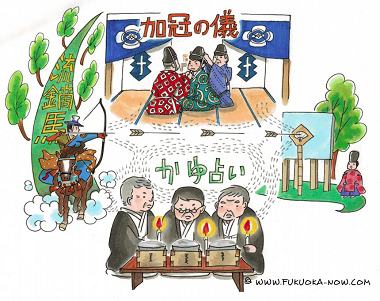Hakata Culture vol.118
Iimori Shrine: Keeper of Ancient Rituals

Located at the foot of Mt. Iimori in Nishi Ward, Iimori Shrine is an ancient shrine said to have been founded in 859 and dedicated to the mountain itself. The shrine used to have three buildings at three different elevations, and roof tiles inscribed with the date 1114 have been excavated from the ruins of the building at the mountain’s summit. The main building, with its exquisite sculptures, was built in 1786. Inside, there still exist guardian lion dogs and ancient documents from the Northern and Southern Courts period (1334 - 1392).
There are also several ancient rituals that are still practiced at Iimori Shrine. One of these is the kayu-uranai (rice porridge fortune telling). On Feb. 14, rice porridge (kayu) is prepared and offered to the shrine, and on Mar. 1 the mold growing on the porridge is “read” to determine how the year’s rice crop will turn out. The area around the shrine has been farmland since olden times, and the ritual reveals how local people have revered the shrine gods as guardians of their crops.
Later in the year, on Oct. 19, there is a yabusame (horseback archery) competition held as part of the annual fall festival. This ritual, which is even mentioned in an ancient document dated 1573, prays for bumper crops, continued good fortune in war and good health. After a ritual cleansing in the ocean in the morning, the archers change into warrior garb and wow the crowd with their skills. The archers are members of households in which yabusame has been handed down for generations.
Another unique event at Iimori Shrine is the genpuku-shiki. Nowadays there are coming of age ceremonies, but in the genpuku-shiki, young men and women wear traditional warrior’s clothing styled on that from the Kamakura period (1185 - 1333) and are crowned with traditional eboshi caps. The word genpuku originally means “to coronate,” and the traditional hats that the young men and women don symbolize their entry into adulthood. This ceremony is now held on the modern Coming of Age Day, the second Monday in January.
古式ゆかしい儀式が残る飯盛神社
福岡市西区の飯盛山のふもとにある飯盛神社は、859年創建とも伝わる古い神社で、飯盛山そのものをご神体としています。以前は頂上からふもとにかけて、上宮、中宮、下宮と3つの社殿があり、上宮跡からは永久2(1114)年の銘を持つ瓦経(経典を刻んだ瓦)が出土しています。また見事な彫刻で飾られた本殿は天明6(1786)年の建立。南北朝時代の狛犬や貴重な古文書も残されています。
社殿や宝物だけでなく、古くからの様式を残す行事も多く伝わっています。そのひとつが、その年の農作の吉凶を占う「かゆ占い」。2月14日に粥を炊いて神前に供え、半月後の3月1日に粥開きの神事が行われ、粥の表面に生えたカビの状態で吉凶を判断します。飯盛神社の周辺は古くからの農村地帯で、昔から農耕の守護神として崇められてきたことを物語っています。
また10月9日に行われる秋季大祭では、馬で駆け抜けながら弓矢で的を射る流鏑馬が奉納されます。元亀4(1573)年の古文書にも記述されている行事で、五穀豊穣・武運長久・無病息災を祈るものです。射手は早朝に海岸で身を清め、武士の衣装を身に着け、観衆の目の前で見事な腕前を披露します。射手となる氏子の家は、数代にわたって流鏑馬を継承しているそうです。
もうひとつユニークなのが元服式。現代でいう成人式ですが、飯盛神社では古式に則った「加冠の儀」という儀式が行われます。成人を迎える男女が鎌倉時代の武家の正装に身を包み、神前で烏帽子を授けてもらいます。もともと「元服」という言葉は「冠をつけること」を意味し、冠や烏帽子は成人男性の象徴でした。古式ゆかしい元服式は、現在の成人式と同じ1月第2月曜に行われます。

